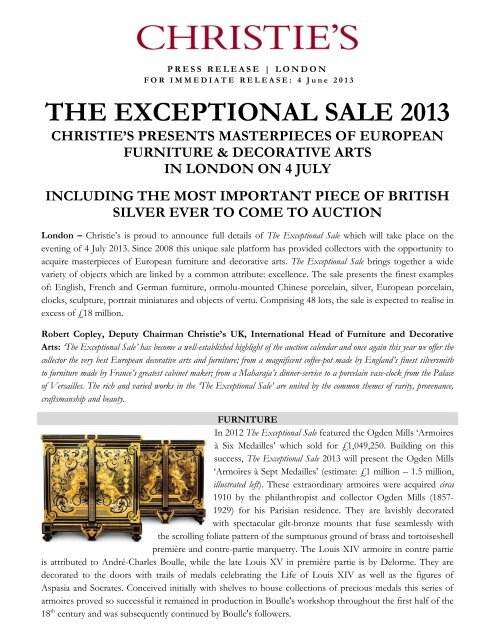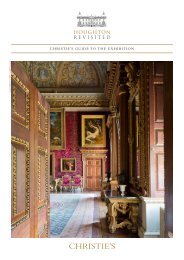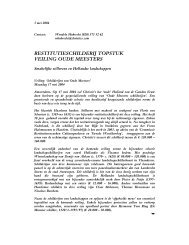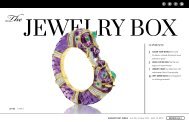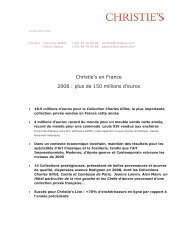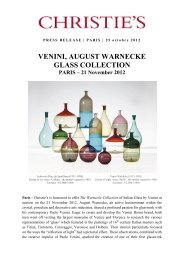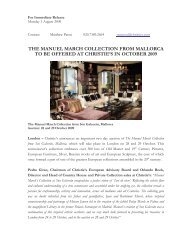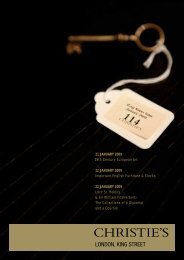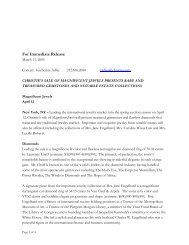THE EXCEPTIONAL SALE 2013 - Christie's
THE EXCEPTIONAL SALE 2013 - Christie's
THE EXCEPTIONAL SALE 2013 - Christie's
Create successful ePaper yourself
Turn your PDF publications into a flip-book with our unique Google optimized e-Paper software.
P R E S S R E L E A S E | L O N D O N<br />
F O R I M M E D I A T E R E L E A S E : 4 J u n e 2 0 1 3<br />
<strong>THE</strong> <strong>EXCEPTIONAL</strong> <strong>SALE</strong> <strong>2013</strong><br />
CHRISTIE’S PRESENTS MASTERPIECES OF EUROPEAN<br />
FURNITURE & DECORATIVE ARTS<br />
IN LONDON ON 4 JULY<br />
INCLUDING <strong>THE</strong> MOST IMPORTANT PIECE OF BRITISH<br />
SILVER EVER TO COME TO AUCTION<br />
London – Christie’s is proud to announce full details of The Exceptional Sale which will take place on the<br />
evening of 4 July <strong>2013</strong>. Since 2008 this unique sale platform has provided collectors with the opportunity to<br />
acquire masterpieces of European furniture and decorative arts. The Exceptional Sale brings together a wide<br />
variety of objects which are linked by a common attribute: excellence. The sale presents the finest examples<br />
of: English, French and German furniture, ormolu-mounted Chinese porcelain, silver, European porcelain,<br />
clocks, sculpture, portrait miniatures and objects of vertu. Comprising 48 lots, the sale is expected to realise in<br />
excess of £18 million.<br />
Robert Copley, Deputy Chairman Christie’s UK, International Head of Furniture and Decorative<br />
Arts: ‘The Exceptional Sale’ has become a well-established highlight of the auction calendar and once again this year we offer the<br />
collector the very best European decorative arts and furniture; from a magnificent coffee-pot made by England’s finest silversmith<br />
to furniture made by France’s greatest cabinet maker; from a Maharaja’s dinner-service to a porcelain vase-clock from the Palace<br />
of Versailles. The rich and varied works in the ‘The Exceptional Sale’ are united by the common themes of rarity, provenance,<br />
craftsmanship and beauty.<br />
FURNITURE<br />
In 2012 The Exceptional Sale featured the Ogden Mills ‘Armoires<br />
à Six Medailles’ which sold for £1,049,250. Building on this<br />
success, The Exceptional Sale <strong>2013</strong> will present the Ogden Mills<br />
‘Armoires à Sept Medailles’ (estimate: £1 million – 1.5 million,<br />
illustrated left). These extraordinary armoires were acquired circa<br />
1910 by the philanthropist and collector Ogden Mills (1857-<br />
1929) for his Parisian residence. They are lavishly decorated<br />
with spectacular gilt-bronze mounts that fuse seamlessly with<br />
the scrolling foliate pattern of the sumptuous ground of brass and tortoiseshell<br />
première and contre-partie marquetry. The Louis XIV armoire in contre partie<br />
is attributed to André-Charles Boulle, while the late Louis XV in première partie is by Delorme. They are<br />
decorated to the doors with trails of medals celebrating the Life of Louis XIV as well as the figures of<br />
Aspasia and Socrates. Conceived initially with shelves to house collections of precious medals this series of<br />
armoires proved so successful it remained in production in Boulle's workshop throughout the first half of the<br />
18 th century and was subsequently continued by Boulle's followers.
Three exceptional pieces by David Roentgen, the most celebrated German<br />
cabinet-maker of the late 18 th century will be offered. Decorated with<br />
enchanting Chinoiserie scenes in Roentgen's trademark marquetry à la<br />
mosaique and mounted with jewel-like ormolu mounts a splendid roll-top<br />
desk is a superb example of Roentgen's work at the height of his career<br />
(estimate: £400,000 – 600,000, illustrated right). Framed by exquisite mounts,<br />
the elegant form, inspired by Parisian models of the new Louis XVI style,<br />
serves as the perfect vehicle for the display of the splendid marquetry for<br />
which Roentgen was rightly celebrated across Europe. Also by Roentgen is a<br />
German ormolu-mounted and brass-inlaid mahogany architect’s desk which<br />
belonged to the Grand Duchess Anna Feodorovna of Russia. It is another excellent<br />
example of Roentgen’s unrivalled craftsmanship, combining exacting quality of construction with the use of<br />
splendid veneers and finely chased gilt-bronze mounts (estimate: £150,000 – 250,000).<br />
Included in a strong selection of exceptional English furniture from stately homes<br />
is the Lord Curzon four-post bed acquired for Kedleston Hall, Derbyshire<br />
(estimate: £80,000 – 120,000, illustrated left). Lord Curzon, Viceroy of India<br />
between 1899 and 1905 and Foreign Secretary (1919 - 1924), inherited the<br />
Kedleston estate in 1916. Passionately interested in architecture and period<br />
interiors and renowned for his extravagant taste, Lord Curzon determined to create<br />
‘authentic’ rooms with appropriate antique furniture for the houses he owned or<br />
leased. Four-poster bedsteads with sumptuous silk damask bed hangings were<br />
among the most treasured and expensive furnishings in an 18 th century mansion.<br />
18 th century four poster bedsteads were few and far between at the beginning of<br />
the 20 th century, and there were none at Kedleston; Lord Curzon was compelled to purchase beds as part of<br />
the refurbishment.<br />
SILVER<br />
Building on the strong results achieved by the silver in The Exceptional Sale 2012, in which the Leinster<br />
Dinner-Service achieved a record price for a British dinner service at auction, The Exceptional Sale <strong>2013</strong> will<br />
offer the finest examples of both British and European silver. Leading the sale is the Lequesne coffee-pot,<br />
the most important coffee-pot ever to come to the market (estimate: £3.5 – 4.5 million). This Rococo<br />
masterpiece by Paul de Lamerie (1688–1751) - the greatest silversmith working in Britain in the 18 th century -<br />
is expected to become the most valuable piece of English silver ever to be sold at auction. For a dedicated press<br />
release please click here.<br />
The Maharaja of Patiala’s banqueting service, commissioned by<br />
the Maharaja in honour of a tour of India in 1922 by Prince<br />
Edward, Prince of Wales, later King Edward VIII and Duke of<br />
Windsor, gives an insight into the Maharaja’s lavish lifestyle<br />
(estimate: £1 million – 1.5 million, illustrated right). This extensive<br />
George V silver-gilt dinner-service comprises over 1,400 pieces.<br />
His wealth and status was such that he was the first man in India<br />
to own an aircraft, for which the Patiala Aviation Club was<br />
founded. He and his wife patronised some of the leading makers<br />
in the world, such as Cartier, whom they commissioned to mount
the De Beers diamond as the centrepiece of the magnificent ‘Patiala Necklace’. The Maharaja was also an avid<br />
and early motorcar enthusiast; indeed legend has it that he would travel in a motorcade of 20 Rolls Royces.<br />
However, in 1930 he had a falling out with Rolls Royce who he felt slighted him by refusing to accept an<br />
order. Such was his power and influence in India that a campaign by him forced the Viceroy to pressure Rolls<br />
Royce to change their decision.<br />
SCULPTURE<br />
A beautiful, over-lifesize statue by Girolamo Campagna (1549 - 1621), is an exciting recent<br />
discovery: it is almost certainly one of the eight figures which the young Veronese sculptor<br />
carved between 1582 and 1584 for the funerary monument to Doge Nicolò Da Ponte<br />
(1491-1585), formerly in the Venetian church of Santa Maria della Carità (estimate:<br />
£600,000 – 1 million, illustrated left). Completed by April 1584, the monument dominated<br />
the right nave of the monastic church for over two centuries. In 1807, however, the Carità<br />
and its associated buildings were chosen as the site for the new Accademia di Belle Arti,<br />
which resulted in the removal of all the monuments, altars and tombs inside the church. It<br />
was believed, until now, that all of the statues by Campagna had been lost. Campagna was<br />
one of the most significant sculptors to have worked in Venice in the 16 th and early 17 th<br />
centuries. Gifted at working in marble, bronze and stucco, by the last decade of the<br />
Cinquecento, he had taken over from Alessandro Vittoria (c. 1525-1608) as the city’s<br />
leading sculptor. He continued to receive major commissions from the state, church and<br />
private patrons until his death in 1621.<br />
A magnificent bronze model of an écorché horse relates to ‘The anatomy of a<br />
horse in patinated metal above a carved marble quadrilateral plinth’ that was<br />
documented in an inventory of 1810 of the workshop of Giuseppe Valadier,<br />
the celebrated Roman bronze founder, architect and designer (estimate:<br />
£500,000 – 800,000, illustrated right). It is one of four casts known to exist on<br />
this scale and is the only one in private hands. Since the Renaissance artists have<br />
been fascinated by the structural qualities of human and animal bodies and<br />
some, such as Leonardo da Vinci, took part in dissections of the body to aid<br />
their study. The first documented écorché models were made in Italy in the<br />
16 th century, often in bronze. Later, the celebrated painter of horses, George<br />
Stubbs (1724-1806), made a remarkable series of engravings of The Anatomy of<br />
the Horse.<br />
PORCELAIN<br />
A pair of ormolu-mounted Sèvres porcelain vases combine colourful<br />
Chinoiserie scenes with faux-lacquer decoration and are also the only known<br />
‘vases fond noir Chinois en or’ surviving in private hands (estimate: £500,000 –<br />
800,000, illustrated left). In the early 1790s, Sèvres produced a selection of table<br />
wares and vases with sumptuous decoration in the manner of Asian lacquer.<br />
Created by painting different shades of gold and platinum on a black ground, the<br />
effect is arguably one of the richest decorations on porcelain ever achieved and<br />
technologically one of the most complex. Of the approximately 40 entries in the<br />
Sèvres records for vases and other pieces of form decorated using this technique,<br />
only 23 are known to have survived, of which nearly all are now in public collections. Only 17 vases have<br />
survived and the present pair are the only ‘vases à bandeau’ recorded as decorated in this style.
William Beckford’s ‘sacred peach’ vases in rare ‘clair-de-lune’ porcelain<br />
and sculpted in relief with a sacred peach, are mounted with superbly<br />
modelled and beautifully chased mounts that can be attributed to Jean-<br />
Claude Chambellan Duplessis (d.1774), one of the most significant<br />
bronziers of the second half of the 18 th century (estimate: £400,000 –<br />
600,000, illustrated right). These sumptuously mounted vases in the late<br />
rococo style of circa 1760 represent a reaction to the fanciful asymmetry<br />
of early rococo, the Goût Pitoresque of the 1730s and 1740s. The vases,<br />
which are part of a very small group of similar vases, display the sacred<br />
peach, often used in Chinese art to symbolize immortality.<br />
CLOCKS<br />
Clocks in The Exceptional Sale include a Chinese paste-gem set ormolu and white marble ‘double<br />
gourd’ clock with swinging dial from the Guangzhou workshops, dating to the Qianlong period<br />
late 18 th century, which is one of only three recorded examples (estimate: £400,000 – 600,000,<br />
illustrated left). Both of the other two examples have been sold by Christie’s. The clock displays<br />
powerful symbolism: the double-gourd design is a potent symbol of fertility and good<br />
fortune; the inverted bat (pien-fu) signifies ‘blessings have arrived’; the character medallion a<br />
sign of ‘Longevity’; the Phoenix heads (feng or fenghuang) an emblem of the Empress and one<br />
of the four Guardians of the Universe.<br />
Further highlights include a musical table clock by James Cox (1723 - 1800),<br />
created in circa 1766, which was previously in the collection of King Farouk I<br />
(estimate: £450,000 – 650,000, illustrated right). Cox operated as a jeweller and<br />
goldsmith from his London premises at Shoe Lane, off Fleet Street. The principal<br />
component parts of the present clock appear throughout his oeuvre. Cox’s clock cases and<br />
necessaires comprise characteristic elements: boldly cast Rococo mounts, a variety of<br />
animals including lizards, elephants and lions to the feet and vase finials combined<br />
throughout with ‘caged’ specimen panels of polished agate. Christie’s has a long<br />
association with Cox, having sold his clocks from as early as 1772.<br />
PORTRAIT MINIATURES & OBJECTS OF VERTU<br />
An enamel plaque by Henry Bone, R.A. (1755 – 1834), the ‘Prince of<br />
Enamellers’, depicting Bacchus and Ariadne, is the artist’s largest and<br />
greatest work (estimate: £80,000 – 120,000, illustrated left). Henry<br />
Bone’s success as an enamellist was cemented when he was officially<br />
appointed Enamel Painter to the Prince of Wales, later Prince Regent,<br />
and to George III. Bacchus and Ariadne was purchased by George<br />
Bowles, an enthusiastic collector of Bone’s work, from the artist for<br />
2,200 guineas in 1811. George Bowles and the Prince of Wales shared<br />
the same taste for Bone’s work and they both owned copies of his<br />
enamel after Cantarini’s Holy Family with an Angel. The vast gilt-wood<br />
frame accompanying the ‘Bacchus and Ariadne’, elaborately carved<br />
with anthemion and scroll motifs and lion’s masks within wreaths, is reminiscent of the Carlton House taste<br />
that the Prince of Wales enjoyed.
A Saxon enamelled gold and hardstone snuff-box by Johann-Christian<br />
Neuber (1736-1808) is one of a small group of Neuber’s snuff-boxes in<br />
which the beauty and rarity of the stone is given greater emphasis than the<br />
gold-work (estimate: £250,000 – 350,000, illustrated right). Lapis-lazuli,<br />
which had to be imported from Afghanistan, was one of the only<br />
hardstones Neuber used that was not found in Saxony. Its unique, intense<br />
colour and composition could not be reproduced by any other stone. This<br />
box, with its beautifully coloured hardstone medallions set within intricate<br />
gold and hardstone borders, highlights Neuber’s extraordinary skill and<br />
imagination which made his objects so sought after at the Saxon Court and<br />
beyond.<br />
PRESS CONTACT: Dernagh O’Leary | +44(0)207 389 2398 | doleary@christies.com<br />
Please click here for the complete eCatalogue<br />
PUBLIC EXHIBITION:<br />
LONDON:<br />
Friday, 7 June: 9:00 am – 4:30 pm<br />
Saturday, 8 June: 12:00 pm – 5:00 pm<br />
Sunday, 9 June: 12:00 pm – 5:00 pm<br />
Monday, 10 June: 9:00 am – 4:30 pm<br />
Tuesday, 11 June <strong>2013</strong>: 9:00 am – 8:00 pm<br />
AUCTION:<br />
The Exceptional Sale<br />
Christie’s London<br />
Thursday, 4 July <strong>2013</strong><br />
19:00<br />
About Christie’s<br />
Friday, 28 June <strong>2013</strong>: 9:00 am – 4:30 pm<br />
Saturday, 29 June <strong>2013</strong>: 10:00 am – 5:00 pm<br />
Sunday, 30 June <strong>2013</strong>: 10:00 am – 5:00 pm<br />
Monday, 1 July <strong>2013</strong>: 9:00 am – 4:30 pm<br />
Tuesday, 2 July <strong>2013</strong>: 9:00 am – 3:30 pm<br />
Wednesday, 3 July <strong>2013</strong>: 9:00 am – 4:30 pm<br />
Thursday, 4 July: 9:00 am – 4:30 pm<br />
Christie’s, the world's leading art business, had global auction and private sales in 2012 that totaled £3.92 billion/$6.27 billion.<br />
Christie’s is a name and place that speaks of extraordinary art, unparalleled service and expertise, as well as international glamour.<br />
Founded in 1766 by James Christie, <strong>Christie's</strong> has since conducted the greatest and most celebrated auctions through the centuries<br />
providing a popular showcase for the unique and the beautiful. Christie’s offers over 450 auctions annually in over 80 categories,<br />
including all areas of fine and decorative arts, jewellery, photographs, collectibles, wine, and more. Prices range from $200 to over<br />
$100 million. <strong>Christie's</strong> also has a long and successful history conducting private sales for its clients in all categories, with emphasis<br />
on Post-War and Contemporary, Impressionist and Modern, Old Masters and Jewellery. Private sales totaled £631.3 million/$1<br />
billion in 2012, an increase of 26% on the same period last year.<br />
Christie’s has a global presence with 53 offices in 32 countries and 10 salerooms around the world including in London, New York,<br />
Paris, Geneva, Milan, Amsterdam, Dubai, Zürich, and Hong Kong. More recently, Christie’s has led the market with expanded<br />
initiatives in growth markets such as Russia, China, India and the United Arab Emirates, with successful sales and exhibitions in<br />
Beijing, Mumbai and Dubai.<br />
*Estimates do not include buyer’s premium. Sales totals are hammer price plus buyer’s premium and do not reflect costs, financing<br />
fees or application of buyer’s or seller’s credits.<br />
# # #<br />
Visit Christie’s Website at www.christies.com<br />
Complete catalogue available online at www.christies.com or via the Christie’s iPhone app


